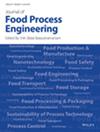This study examined the effect of various process factors on the drying of fresh water filleted prawns (Macrobrachium felicinum). The aim was to obtain data utilizing experimental and theoretical analysis that can be applied in equipment development and process optimization for drying seafood. Thus, pre-treated prawns at different brine concentrations were dried at three isothermal conditions using a laboratory oven. The experimental moisture content data was changed to a moisture ratio and was employed to determine the drying attributes of the prawn. Drying condition optimality was explored more for model suitability using seven drying models in existence. Treatment of the prawns at a brine concentration of 2–6% affected the drying kinetics. The effective moisture diffusivity and activation energy for brine treatments ranged from 3.66 × 10−7 to 7.52 × 10−7 m2/s and 39.09 to 40.86 kJ/mol respectively while the specific energy required for the drying procedure varied from 44.52 to 76.34 kWh/kg after 9–14 h continuous drying at 50–70°C. Furthermore, the drying data's optimization demonstrated that the optimum temperature for drying filleted prawns in thin layers was 60.59°C with a brining concentration of 4.35%. The moisture ratio data fitted into semi-theoretical and empirical model revealed that the Page model was the best model for samples pretreated by 0%, 4%, and 6% brine, whereas the Logarithmic model was the best-fit for the samples brined with 2% solution. The study's data will be useful in developing and assessing drying techniques and systems for prawns and other related freshwater products.
Prawns (Macrobrachium felicinum) are a common dietary item in several countries, and demand for dried marine food delicacies is increasing as they are high in antioxidant poly-unsaturated fatty acids, astaxanthin, and vitamin B12. However, because prawns are highly perishable and post-harvest losses are predicted to make up 35% of daily catches, drying is required to minimize these losses. To guarantee that the drying process is both efficient and cost-effective, optimum drying conditions must be established. As a result, this study was carried out to produce data that would be useful for drying pretreated prawn fillets.


